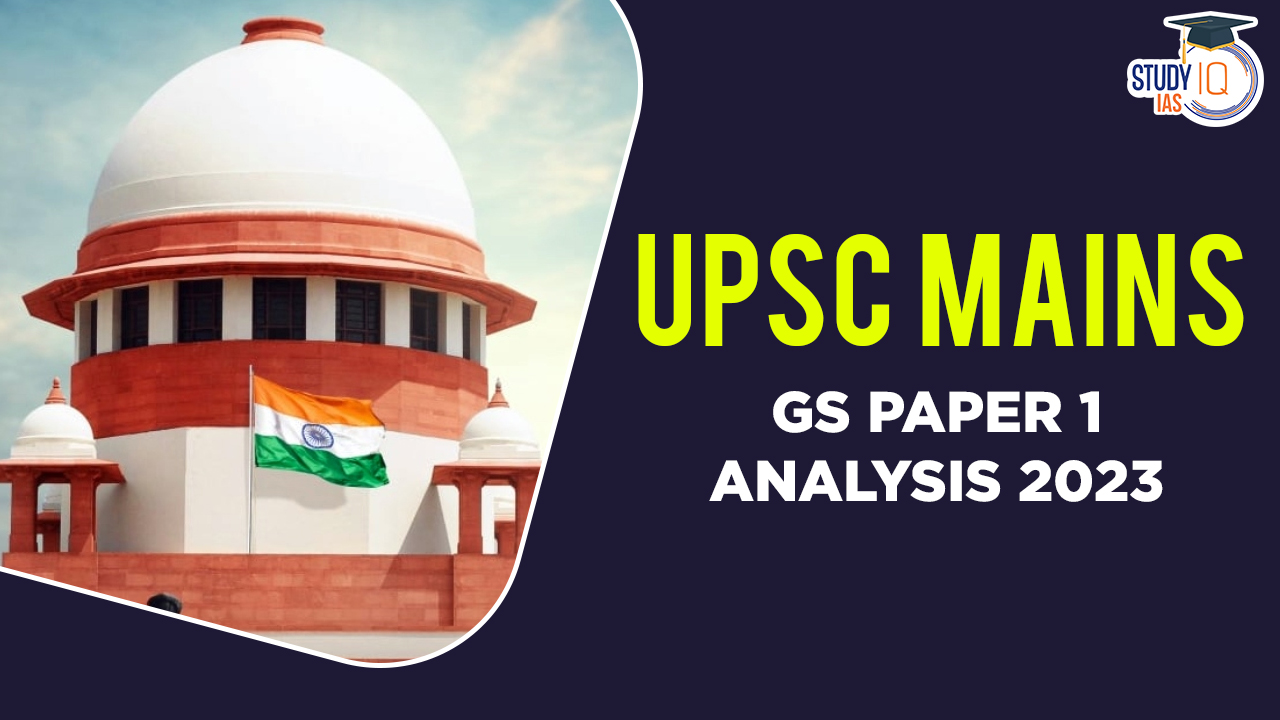Table of Contents
UPSC Mains GS Paper 1 Analysis 2023
Mains General Studies Paper 1 is one of the most crucial papers in the UPSC Civil Services Examination. Unlike other papers, the first paper specifically focuses on multiple essential areas, such as History, Art and culture, Post Independence History, Geography, and Society. Here, we have done the UPSC Mains GS Paper 1 Analysis for the candidates to understand the pattern in which UPSC has asked the questions in recent years.
The UPSC Mains GS Paper 1 Analysis will help you to identify the difficulty level and the nature of the questions asked in the UPSC Mains exam. This article exhaustively covers the UPSC Mains GS Paper 1 Analysis along with UPSC Mains GS Paper 1 Previous Year Questions.
UPSC Mains GS Paper I 2023 PDF
The UPSC Mains GS Paper I 2023 PDF has been made available for the candidates. The exam was successfully administered by UPSC at Forenoon on September 16, 2023. 9:00 AM – 12:00 PM, session. The UPSC Mains GS Paper I is 250 Marks. Candidates can check the UPSC Mains GS Paper I 2023 PDF Link below.
| UPSC Mains GS Paper I 2023 PDF | |
| General Studies Paper | Download Link |
| UPSC Mains GS Paper I Question | PDF Download Link |
UPSC Mains GS Paper I 2023 Detailed Discussion Question-wise
Candidates who are taking the UPSC Mains Exam 2023 can check the Question-Wise detailed discussion on UPSC Mains GS Paper I 2023 below. Click on the provided link below:
| Que No. | Que Link | Section/Subject | Marks |
| 1 | Explain the role of geographical factors towards the development of Ancient India.
प्राचीन भारत के विकास की दिशा में भौगोलिक कारकों की भूमिका को स्पष्ट कीजिए। |
Art & Culture | 10 marks |
| 2 | What was the difference between Mahatma Gandhi and Rabindranath Tagore in their approach towards education and nationalism?
महात्मा गाँधी और रवीन्द्रनाथ टैगोर में शिक्षा और राष्ट्रवाद के प्रति सोच में क्या अंतर था? |
Modern History | 10 Marks |
| 3 | Bring out the socio-economic effects of the introduction of railways in different countries of the world.
विश्व के विभिन्न देशों में रेलवे के आगमन से होने वाले सामाजिक-आर्थिक प्रभावों को उजागर कीजिए। |
World History | 10 Marks |
| 4 | Discuss the consequences of Climate Change on food security in tropical Countries.
उष्णकटिबंधीय देशों में खाद्य सुरक्षा पर जलवायु परिवर्तन के परिणामों की विवेचना कीजिए। |
Geography | 10 Marks |
| 5 | Why is the world today confronted with a crisis of availability of and access to freshwater resources.
आज विश्व ताजे जल के संसाधनों की उपलब्धता और पहुँच के संकट से क्यों जूझ रहा है? |
Geography | 10 Marks |
| 6 | How are the fjords formed? Why do they constitute some of the most picturesque areas of the world?
फियॉर्ड कैसे बनते हैं? वे दुनिया के कुछ सबसे सुरम्य क्षेत्रों का निर्माण क्यों करते हैं? |
Geography | 10 Marks |
| 7 | Why is the South-West Monsoon called ‘Purvaiya” (easterly) in Bhojpur region? How has this directional seasonal wind system influenced the cultural ethos of the region.
दक्षिण-पश्चिम मानसून भोजपुर क्षेत्र में ‘पुरवैया’ (पूर्वी) क्यों कहलाता है? इस दिशापरक मौसमी पवन प्रणाली ने क्षेत्र के सांस्कृतिक लोकाचार को कैसे प्रभावित किया है? |
Geography | 10 Marks |
| 8 | Do you think marriage as a sacrament is loosing its value in modern India?
क्या आप सोचते हैं कि, आधुनिक भारत में विवाह एक संस्कार के रूप में अपना मूल्य खोता जा रहा है? |
Society | 10 Marks |
| 9 | Why suicide among young women is increasing in Indian society?
भारतीय समाज में नवयुवतियों में आत्महत्या क्यों बढ़ रही है? स्पष्ट कीजिए। |
Society | 10 Marks |
| 10 | Child cuddling is now being replaced by mobile phones. Discuss its impact on the socialization of children.
बच्चे को दुलारने की जगह अब मोबाइल फोन ने ले ली है। बच्चों के समाजीकरण पर इसके प्रभाव की चर्चा कीजिए। |
Society | 10 Marks |
| 11 | What are the main features of Vedic society and religion? Do you think some of the features are still prevailing in Indian society?
वैदिक समाज और धर्म की मुख्य विशेषताएँ क्या है? क्या आप सोचते हैं कि उनमें से कुछ विशेषताएँ भारतीय समाज में अभी भी प्रचलित है? |
Ancient & Medieval History | 15 Marks |
| 12 | What were the major technological changes introduced during the Sultanate period? How did those technological changes influence the Indian society?
सल्तनत काल के दौरान किये गये बड़े तकनीकी बदलाव क्या थे? उन तकनीकी बदलावों ने भारतीय समाज को कैसे प्रभावित किया था? |
Ancient & Medieval History | 15 Marks |
| 13 | How did colonial rule affect the tribal in India and what was the tribal response to colonial oppression?
भारत में औपनिवेशिक शासन ने आदिवासियों को कैसे प्रभावित किया और औपनिवेशिक उत्पीड़न के प्रति आदिवासी प्रतिक्रिया क्या थी? |
Modern History | 15 Marks |
| 14 | Comment on the resource potentials of the long coastline of India and Highlight the status of natural hazard preparedness in these areas.
भारत की लंबी तटरेखीय संसाधन क्षमताओं पर टिप्पणी कीजिए और इन क्षेत्रों में प्राकृतिक खतरे की तैयारी की स्थिति पर प्रकाश डालिए। |
Geography | 15 Marks |
| 15 | Identify and discuss the factors responsible for diversity of Natural Vegetation in India. Assess the significance of wildlife sanctuaries in rainforest regions of India.
भारत में प्राकृतिक वनस्पति की विविधता के लिए उत्तरदायी कारकों को पहचानिए और उनकी विवेचना कीजिए। भारत के वर्षा वन क्षेत्रों में वन्यजीव अभयारण्यों के महत्व का आकलन कीजिए। |
Geography | 15 Marks |
| 16 | Why did Human development fail to keep pace with economic development in India.
भारत में मानव विकास आर्थिक विकास के साथ कदमताल करने में विफल क्यों हुआ? |
Geography | 15 Marks |
| 17 | From being a net food importer in the 1960s, India has emerged as a net food exporter to the world. Provide reasons.
1960 के दशक में शुद्ध खाद्य आयातक से, भारत विश्व में एक शुद्ध खाद्य निर्यातक के रूप में उभरा। कारण दीजिए। |
Geography | 15 Marks |
| 18 | Does urbanisation lead to more segregation and/or marginalisation of the poor in Indian metropolises.
क्या भारतीय महानगरों में शहरीकरण गरीबों को और भी अधिक पृथकरण और / या हाशिए पर ले जाता है? |
Society | 15 Marks |
| 19 | Why is caste identity in India both static and fluid?
भारत में जातीय अस्मिता गतिशील और स्थिर दोनों ही क्यों है? |
Society | 15 Marks |
| 20 | Discuss the impact of post-liberal economy on ethnic identity of communalism.
संजातीय पहचान एवं सांप्रदायिकता पर उत्तर-उदारवादी अर्थव्यवस्था के प्रभाव की विवेचना कीजिए। |
Society | 15 Marks |
Check Out UPSC Mains GS Paper 3 Analysis
UPSC Mains GS Paper 1 Trend Analysis 2018-2023
The UPSC Mains GS Paper 1 trend analysis shows that the paper is becoming increasingly challenging and analytical in nature. The questions are designed to test the candidates’ knowledge of a wide range of topics, including history, geography, society, and culture. The paper also emphasizes the importance of current affairs and the ability to think critically and apply knowledge to real-world problems.
As compared to other general studies papers, the GS Paper 1 syllabus has subjects where mostly direct questions are being asked and is static in nature. As in the case of History of GS paper-I. In subjects such as ancient, medieval, modern, and world history direct questions are being asked. Although sections such as Indian Society and Geography, candidates need to connect the static section of GS Paper 1 with the current affairs. Check the UPSC Mains GS Paper 1 Analysis 2018-2023 below.
UPSC Mains GS Paper 1 Trend Analysis: History
History is an important subject for both UPSC Prelims and Mains exams. After completing the UPSC history syllabus, aspirants must check the sectional weightage of topics asked in the UPSC Mains GS Paper 1. The History GS 1 previous year questions are asked from the following topics:
- Important events, personalities, etc. in Indian History from mid 18th century till date;
- World History;
- The freedom struggle of India;
- The post-Independence period in India including the reorganization of states;
Candidates can check the UPSC Mains GS Paper 1 Analysis of History asked from 2018 to 2023 in the table below.
| GS Paper 1 Previous Year Questions – History |
|||||
| Year of Exam | History | Post Independence | World History | Total Number of Questions | Total Marks |
| 2023 | 4 | 0 | 1 | 5 | 55 Marks |
| 2022 | 2 | 0 | 0 | 2 | 35 Marks |
| 2021 | 3 | 0 | 2 | 5 | 65 Marks |
| 2020 | 2 | 0 | 0 | 2 | 25 Marks |
| 2019 | 2 | 1 | 1 | 4 | 65 Marks |
| 2018 | 1 | 2 | 0 | 3 | 25 Marks |
UPSC Mains GS Paper 1 Trend Analysis: Art and Culture
The section on Art and Culture consists of questions from subtopics such as different types of art forms and literature in India, ancient to modern architecture, etc. The UPSC Mains GS Paper 1 Analysis of Art and Culture from 2018 to 2023 have been provided below:
| UPSC Mains GS Paper 1 Analysis – Art and Culture | ||
| Year of Exam | Total Number of Questions | Total Marks |
| 2023 | 1 | 10 Marks |
| 2022 | 3 | 40 Marks |
| 2021 | 1 | 10 Marks |
| 2020 | 4 | 50 Marks |
| 2019 | 1 | 10 Marks |
| 2018 | 3 | 35 Marks |
UPSC Mains GS Paper 1 Trend Analysis: Geography
The section of Geography includes as Industrialization and Urbanization, Climate, Physical Geography, Natural resources, Indian and World Geography, etc. In general, 5-8 questions are asked from Geography of GS Paper 1. Check the UPSC Mains GS Paper 1 Analysis – Geography below in the table:
| UPSC Mains GS Paper 1 Analysis – Geography | ||
| Year of Exam | Total Number of Questions | Total Marks |
| 2023 | 8 | 100 Marks |
| 2022 | 9 | 115 Marks |
| 2021 | 8 | 95 Marks |
| 2020 | 8 | 85 Marks |
| 2019 | 8 | 75 Marks |
| 2018 | 4 | 70 Marks |
UPSC Mains GS Paper 1 Trend Analysis: Indian Society
The section of Indian Society in Gs Paper 1 includes topics such as the role of women in society, issues faced by them, diversity in Indian society, poverty, globalization, communalism, secularism, etc. The table below shows the UPSC Mains GS Paper 1 Analysis of Indian Society.
| GS1 Previous Year Questions – Indian Society |
||
| Year of Exam | Total Number of Questions | Total Marks |
| 2023 | 6 | 75 Marks |
| 2022 | 4 | 60 Marks |
| 2021 | 6 | 80 Marks |
| 2020 | 6 | 90 Marks |
| 2019 | 10 | 95 Marks |
| 2018 | 11 | 125 Marks |
GS Paper 1 Mains Previous Year Papers 2023-2018
Download the year-wise GS Paper 1 previous year papers PDF for the years 2023 to 2018 to be better prepared for the upcoming exam.
| GS Paper 1 previous year questions PDF (2023-2018) | |
| Year of Mains Exam | GS Paper 1 Previous Year Questions PDF Link |
| UPSC Mains Exam 2023 | GS Paper 1 2023 PDF |
| UPSC Mains Exam 2022 | GS Paper 1 Previous Year Questions 2022 PDF |
| UPSC Mains Exam 2021 | GS Paper 1 Previous Year Questions 2021 PDF |
| UPSC Mains Exam 2020 | GS Paper 1 Previous Year Questions 2020 PDF |
| UPSC Mains Exam 2019 | GS Paper 1 Previous Year Questions 2019 PDF |
| UPSC Mains Exam 2018 | GS Paper 1 Previous Year Questions 2018 PDF |


 UPSC CMS Admit Card 2025 Out: Download L...
UPSC CMS Admit Card 2025 Out: Download L...
 UPSC Study Material for Prelims & Ma...
UPSC Study Material for Prelims & Ma...
 Story of Meera Bai and Her Devotion For ...
Story of Meera Bai and Her Devotion For ...





















